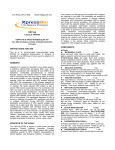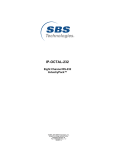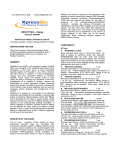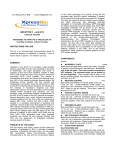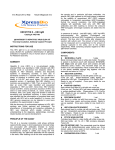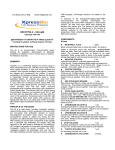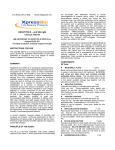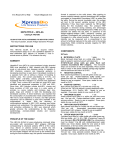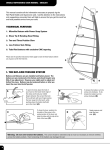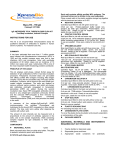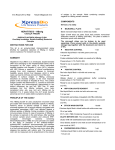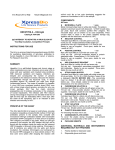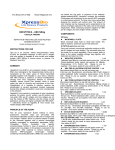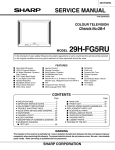Download HEPATITIS D – IgG
Transcript
For Research Use Only Not for Diagnostic Use HEPATITIS D – IgG Catalog #: WD6196 ANTIBODIES TO HEPATITIS D VIRUS ELISA KIT Two-Step Incubation, Indirect Principle INSTRUCTIONS FOR USE This kit is an enzyme-linked immunosorbent assay (ELISA) for qualitative determination of IgG antibodies to hepatitis D virus (HDV) in human serum or plasma. For Research Use Only SUMMARY Hepatitis D is a liver diseases caused by Hepatitis D virus (Delta agent) – a defective (36 nm-43 nm) enveloped RNA virus, which requires co-infection with Hepatitis B virus (HBV) for its replication. Transmitted percutaneously or sexually through contact with infected blood or blood products, HDV is associated with the most severe forms of chronic and acute hepatitis in many Hepatitis B -HBsAg positive patients. Since the infection with HDV requires infection with HBV, the development of the disease depends on whether the two viruses infect simultaneously (coinfection) or whether the newly infected HDV patient is also a chronic HBV carrier (superinfection). The coinfection with HDV can lead to severe acute hepatitis disease with low risk of chronic stage development. Chronic HBV carrier patients superinfected with HDV are at risk to develop chronic HDV disease, which can lead to cirrhosis in 70%-80% of the patients. The serological diagnosis of HDV is based on detection of specific HDV antibodies (anti-HDV) or antigens. The anti-HDV IgG antibodies are indicator of past or current delta infection. High titers of the antibodies may be indicative of chronic or active infection. During HBV-HDV, co-infection detectable concentrations of anti-HDV IgG appear after the tenth week of exposure to the viruses and clearance during convalescence indicates recovery. During HDV superinfection, detectable levels of antibodies appear four to six weeks after exposure and failure to clear indicates possible progression to long, chronic carrier stage. PRINCIPLE OF THE ASSAY This kit is based on solid phase, two-step incubation indirect ELISA method. Polystyrene microwell strips are pre-coated with recombinant HDV antigens. During the first incubation step, anti-HDV specific antibodies, if present, will be bound to the solid phase pre-coated HDV antigens. The wells are washed to remove unbound serum proteins, and anti-human IgG antibodies (anti-IgG) conjugated to the enzyme horseradish peroxidase (HRPConjugate) are added. During the second incubation step, these HRP-conjugated antibodies will be bound to any antigen-antibody(IgG) complexes previously formed and the unbound HRP-conjugate is then removed by washing. Chromogen solutions containing Tetramethylbenzidine (TMB) and urea peroxide are added to the wells and in presence of the antigen-antibody-anti-IgG (HRP) immunocomplex, the colorless Chromogens are hydrolyzed by the bound HRP conjugate to a blue-colored product. The blue color turns yellow after stopping the reaction with sulfuric acid. The amount of color intensity can be measured and it is proportional to the amount of antibody captured in the wells, and to the amount of antibody in the sample respectively. Wells containing samples negative for HDV IgG remain colorless. COMPONENTS 96 Tests MICROWELL PLATE 1 plate Blank microwell strips fixed on white strip holder. The plate is sealed in aluminium pouch with desiccant. 8×12/12×8-well strips per plate. Each well contains purified HDV antigens. The microwell strips can be broken to be used separately. Place unused wells or strips in the plastic sealable storage bag together with the desiccant and return to 2~8ºC. NEGATIVE CONTROL 1 vial Blueish liquid filled in a vial with green screw cap. 0.5 ml per vial. Protein-stabilized buffer tested nonreactive for anti-HDV. Preservatives: 0.1% ProClin 300. Ready to use as supplied. Once open, stable for one month at 2-8ºC POSITIVE CONTROL 1 vial Red-colored liquid filled in a vial with red screw cap. 0.5 ml per vial. Anti-HDV diluted in protein-stabilized buffer. Preservatives: 0.1% ProClin 300. Ready to use as supplied. Once open, stable for one month at 2-8ºC. HRP-CONJUGATE REAGENT 1 vial Red-colored liquid filled in a white vial with red screw cap. 12 ml per vial. Horseradish peroxidase-conjugated antiHDV antibodies. Ready to use as supplied. Once open, stable for one month at 2-8ºC. SAMPLE DILUENT 1 vial Blue-colored liquid filled in a white vial with blue crew cap. 12 ml per vial. Protein buffer solution. Preservatives:0.1% ProClin 300 STOCK WASH BUFFER 1 bottle Colorless liquid filled in a clear bottle with white screw cap. 50ml per bottle. pH 7.4 20× PBS (Containing Tween-20 as a detergent). DILUTE BEFORE USE: The concentrate must be diluted 1 to 20 with distilled/deionized water before use. Once diluted, stable for one week at room temperature, or for two weeks when stored at 2-8ºC. CHROMOGEN SOLUTION A 1 vial Colorless liquid filled in white vial with green screw cap. 7ml per vial. Urea peroxide solution. Ready to use as supplied. Once open, stable for one month at 2-8ºC. CHROMOGEN SOLUTION B 1 vial Colorless liquid filled in a black vial with black screw cap. 7ml per vial. TMB solution (Tetramethyl benzidine dissolved in citric acid). Ready to use as supplied. Once open, stable for one month at 2-8ºC. STOP SOLUTION 1 vial Colorless liquid filled in a white vial with white screw cap. 7 ml per vial. Diluted sulfuric acid solution (2.0M H2SO4). Ready to use as supplied. PLASTIC SEALABLE BAG 1 unit For enclosing the strips not in use. CARDBOARD PLATE COVER 2 sheets To cover the plates during incubation and prevent evaporation or contamination of the wells. PACKAGE INSERTS 1 copy SPECIAL INSTRUCTIONS FOR WASHING 1. 2. 3. ADDITIONAL MATERIALS AND INSTRUMENTS REQUIRED BUT NOT PROVIDED 4. 1. 2. 3. Freshly distilled or deionized water. Disposable gloves and timer. Appropriate waste containers for potentially contaminated materials. 4. Disposable V-shaped troughs. 5. Dispensing system and/or pipette (single or multichannel), disposable pipette tips. 6. Absorbent tissue or clean towel. 7. Dry incubator or water bath, 37±0.5ºC. 8. Microshaker for dissolving and mixing conjugate with samples. 9. Microwell plate reader, single wavelength 450nm or dual wavelength 450nm and 630nm. 10. Microwell aspiration/wash system. 5. 6. 7. SPECIMEN COLLECTION,TRANSPORTATION AND STORAGE 1. 2. Sample Collection: Either fresh serum or plasma samples can be used for this assay. Blood collected by venipuncture should be allowed to clot naturally and completely – the serum/plasma must be separated from the clot as early as possible as to avoid hemolysis of the RBC. Care should be taken to ensure that the serum samples are clear and not contaminated by microorganisms. Any visible particulate matters in the sample should be removed by centrifugation at 3000 RPM for at least 20 minutes at room temperature, or by filtration on 0.22u filters. Plasma samples collected into EDTA, sodium citrate or heparin may be tested, but highly lipaemic, icteric, or hemolized samples should not be used as they could give erroneous results in the assay. Do not heat inactivate samples. This can cause sample deterioration. Transportation and Storage: Store samples at 28ºC. Samples not required for assaying within 3 days should be stored frozen (-20ºC or lower).Multiple freeze-thaw cycles should be avoided. For shipment, samples should be packaged and labeled in accordance with the existing local and international regulations for transport of clinical samples and ethological agents. A good washing procedure is essential to obtain correct and precise analytical data. It is therefore recommended to use a good quality ELISA microplate washer, maintained at the best level of washing performances. In general, no less than 5 automatic washing cycles with dispensing of 350-400μl/well, are sufficient to avoid false positive reactions and high background (all wells turn yellow). To avoid cross-contaminations of the plate with sample or HRP-conjugate, after incubation do not discard the content of the wells, but allow the plate washer to aspirate it automatically. Anyway, we recommend calibrating the washing system on the kit itself in order to match the declared analytical performances. Assure that the microplate washer’s liquid dispensing channels are not blocked or contaminated, and sufficient volume of Wash buffer is dispensed each time into the wells. In case of manual washing, we suggest to perform at least 5 cycles, dispensing 350-400μl/well and aspirating the liquid for 5times. If poor results (high background) are observed, increase the washing cycles or soaking time per well. In any case, the liquid aspirated out the strips should be treated with a sodium hypochlorite solution (final concentration of 2.5%) for 24 hours, before liquids are disposed in an appropriate way. The concentrated Washing solution should be diluted 1 to 20 before use. For one plate, mix 50ml of the concentrate with 950ml of water for a final volume of 1000ml diluted Wash Buffer. If less than a whole plate is used, prepare the proportional volume of solution. STORAGE AND STABILITY The components of the kit will remain stable through the expiration date indicated on the label and package when stored between 2-8 ºC, do not freeze. To assure maximum performance of this HDV IgG kit, protect the reagents from contamination with microorganism or chemicals during storage. PRECAUTIONS AND SAFETY This kit is intended FOR RESEARCH USE ONLY The ELISA assay is a time and temperature sensitive method. To avoid incorrect result, strictly follow the test procedure steps and do not modify them. 1. 2. Do not exchange reagents from different lots, or use reagents from other commercially available kits. The components of the kit are precisely matched as to achieve optimal performance during testing. Make sure that all reagents are within the validity indicated on the kit box and are of the same lot. 3. 4. 5. 6. 7. 8. 9. 10. 11. 12. 13. 14. 15. 16. 17. Never use reagents beyond the expiry date stated on reagents labels or on the kit box. CAUTION - CRITICAL STEP: Allow the reagents and samples to stabilize at room temperature (1830ºC) before use. Shake reagent gently before, and return to 2-8ºC immediately after use. Use only sufficient volume of sample as indicated in the procedure steps. Failure to do so may cause in low sensitivity of the assay. Do not touch the bottom exterior of the wells; fingerprints or scratches may interfere with microwell reading. When reading the results, ensure that the plate bottom is dry and there are no air-bubbles inside the wells. Never allow the microplate wells to dry after the washing step. Immediately proceed to the next step. Avoid the formation of air-bubbles when adding the reagents. Avoid assay steps long time interruptions. Assure same working conditions for all wells. Calibrate the pipette frequently to assure the accuracy of samples/reagents dispensing. Always use different disposal pipette tips for each specimen and reagents as to avoid cross-contaminations. Never pipette solutions by mouth. The use of automatic pipettes is recommended. Assure that the incubation temperature is 37ºC inside the incubator. When adding samples, avoid touching the well’s bottom with the pipette tip. When reading the results with a plate reader, it is recommended to determine the absorbance at 450nm or at 450nm with reference at 630nm. All specimens from human origin should be considered as potentially infectious. Materials from human origin may have been used in the kit. These materials have been tested with tests kits with accepted performance and found negative for antibodies to HIV ½, HCV, TP and HBsAg. However, there is no analytical method that can assure that infectious agents in the specimens or reagents are completely absent. Therefore, handle reagents and specimens with extreme caution as if capable of transmitting infectious diseases. Strict adherence to GLP (Good Laboratory Practice) regulations can ensure the personal safety. Never eat, drink, smoke, or apply cosmetics in the assay laboratory. Bovine derived sera may have been used in this kit. Bovine serum albumin (BSA) and fetal calf sera (FCS) are derived from animals from BSE/TSE free areas. The pipette tips, vials, strips and sample containers should be collected and autoclaved for 1hour at 121ºC or treated with 10% sodium hypochlorite for 30minutes to decontaminate before any further steps for disposal. The Stop solution (2M H2SO4) is a strong acid. Corrosive. Use it with appropriate care. Wipe up spills immediately or wash with water if come into contact with the skin or eyes. ProClin 300 used as a preservative can cause sensation of the skin. 18. The enzymatic activity of the HRP-conjugate might be affected from dust, reactive chemical, and substances like sodium hypochlorite, acids, alkalis etc. Do not perform the assay in the presence of such substances. 19. Materials Safety Data Sheet (MSDS) available upon request. 20. If using fully automated microplate processing system, during incubation, do not cover the plates with the plate cover. The tapping out of the remainders inside the plate after washing, can also be omitted. ASSAY PROCEDURE Step 1 Step 2 Setp 3 Step 4 Step 5 Step 6 Step 7 Reagents preparation: Allow the reagents to reach room temperature (18-30C) for at least 15-30 minutes. Check the Wash Buffer concentrate for the presence of salt crystals. If crystals have formed in the solution, resolubilize by warming at 37ºC until crystals dissolve. Dilute the stock wash buffer 1 to 20 with distilled or deionized water. Use only clean vessels to dilute the Wash buffer. Numbering Wells: Set the strips needed in stripholder and number sufficient number of wells including three Negative control (e.g. B1, C1, D1), two Positive control (e.g. E1, F1) and one Blank (e.g. A1, Neither samples nor HRPConjugate should be added into the Blank well). If the results will be determined by using dual wavelength plate reader, the requirement for use of Blank well could be omitted. Use only number of strips required for the test. Adding Sample Diluent: Dispense 100 l of Sample diluent provided with the kit into each well except in the Blank well. Adding Sample: Add 10l specimen, 10l Negative control, and 10l Positive control into their respective wells. Note: Use a separate disposal pipette tip for each specimen, Negative, Positive Control as to avoid crosscontamination. Mix by tapping the plate gently. Incubating: Cover the plate with the plate cover and incubate for 30 minutes at 37ºC. It is recommended to use thermostat-controlled water tank to assure the temperature stability and humidity during the incubation. If dry incubator is used, do not open the door frequently. Washing: Remove and discard the plate cover. Wash each well 5 times with diluted Washing buffer. Each time, allow the microwells to soak for 30-60 seconds. After the final washing cycle, turn down the plate onto blotting paper or clean towel, and tap it to remove any remaining liquids. Adding HRP-Conjugate: Add 100l of antibody HRP-Conjugate to each well except the blank. Step 8 Incubating (2): Cover the plate with the plate cover and incubate for 30 minutes at 37ºC (as Step 5). Step 9 Washing (2): Remove and discard the plate cover. Wash each well 5 times with diluted Washing buffer. Each time, allow the microwells to soak for 30-60 seconds. After the final washing cycle, turn down the plate onto blotting paper or clean towel, and tap it to remove any remaining liquids (as step 6). Step 10 Coloring: Add 50l of Chromogen A and 50l Chromogen B solution into each well, cover the plate with plate cover and mix gently. Incubate at 37ºC for 15 minutes avoiding light. The enzymatic reaction between Chromogen solutions and the HRP-Conjugate produces blue color in Positive control and HDV-IgM positive sample wells. Step 11 Stopping Reaction: Remove and discard the plate cover. Using a multichannel pipette or manually add 50l Stop solution into each well and mix gently. Intensive yellow color develops in Positive control and HDV IgG positive sample wells. Step 12 Measuring the Absorbance: Calibrate the plate reader with the Blank well and read the absorbance at 450nm. If a dual filter instrument is used, set the reference wavelength at 630nm. Calculate the Cut-off value and evaluate the results (Note: read the absorbance within 10 minutes after stopping the reaction). Chromogens and Stop solution, is less than 0.080 at 450 nm. 2. The OD value of the Positive control must be equal to or greater than 0.800 at 450/630nm or at 450nm after blanking. 3. The OD value of the Negative control must be less than 0.100 at 450/630nm or at 450nm after blanking. 3. Interpretations of the results: (S = the individual absorbance (OD) of each specimen) Negative Results (S/C.O. <1):Samples giving absorbance less than the Cut-off value are negative for this assay, which indicates that no IgG-class antibodies to HDV have been detected with this kit. Positive Results (S/C.O.≥1): Samples giving an absorbance greater than or equal to Cut-off value are considered initially reactive, which indicates that IgG-class antibodies to HDV have probably been detected with this HDV IgG ELISA kit. Any initially reactive samples should be retested in duplicates. Repeatedly reactive samples could be considered positive for IgG antibodies to HDV. Borderline (S/CO =0.9-1.1) :Samples with absorbance to Cut-off ratio between 0.9 and 1.1 are considered borderline. Retesting of these samples in duplicates is recommended. Repeatedly reactive samples could be considered positive for IgG antibodies to HDV. LIMITATIONS 1. 2. INTERPRETATION OF RESULTS AND QUALITY CONTROL Each microplate should be considered separately when calculating and interpreting results of the assay, regardless of the number of plates concurrently processed. The results are calculated by relating each sample’s optical density (OD) value to the Cut-off value (C.O.) of the plate. If the Cut-off reading is based on single filter plate reader, the results should be calculated by subtracting the Blank well OD value from the print report values of samples and controls. In case the reading is based on dual filter plate reader, do not subtract the Blank well OD from the print report values of samples and controls. 1. Calculation of Cut-off value Cut-off value (C.O.) = *NC + 0.12 *NC = the mean absorbance value for three negative controls. Example: Calculation of NC: control values does not meet the If1.one of the Negative Well Nocontrol rangeB1 C1 D1it should be discarded Quality specifications, Negative Csontrols value 0.02again 0.012 and the mean valueOD is calculated using0.016 the reaining NC=0.016 two values. If more than one negative control OD value 2. Calculation (C.O.)= 0.12 = 0.136 the does not meet of theCut-off Quality control0.016 range+ specifications, test is invalid and must be repeated. 2. Quality control range: 1. The OD value of the Blank well, which contains only 3. 4. 5. Non-repeatable positive result may occur due to the general biological and biochemical characteristics of ELISA assays. The test is design to achieve very high performance characteristics of sensitivity and specificity. However, antibodies may be undetectable during the early stages of the disease and in some immunosuppressed individuals. The prevalence of the marker will affect the assay’s predictive values. Common sources for mistakes: kits beyond the expiry date, bad washing procedures, contaminated reagents, incorrect assay procedure steps, insufficient aspiration during washing, failure to add samples or reagents, equipment, timing, volumes, sample nature and quality. If, after retesting of the initially reactive samples, the assay results are negative, these samples should be considered as non-repeatable (false positive) and interpreted as negative. As with many very sensitive ELISA assays, false positive results can occur due to the several reasons, most of which are related but not limited to inadequate washing step. This is a qualitative assay and the results cannot be use to measure antigens concentrations. INDICATIONS OF INSTABILITY OR DETERIORATION OF THE REAGENTS 1. Values of the Positive or Negative controls ,which are out of the indicated Quality control range, are indicator of possible deterioration of the reagents and/or operator or equipment errors. In such case, the results 2. should be considered as invalid and the samples must be retested. In case of constant erroneous results classified as due to deterioration or instability of the reagents, immediately substitute the reagents with new ones. If after mixing of the Chromogen A and B solutions into the wells, the, the color of the mixture turns blue within few minutes, do not continue carrying out the testing and replace the reagents with fresh ones. VALIDITY Please do not use this kit beyond the expiration indicated on the kit box and reagent labels. REFERENCES: 1. Purcell RHrd and Gerin JL, Hepatitis Delta virus. In: Fields Virology,3 ed. Philadelphia,Lippincott-Raven,1996. 2. Hadziyannis SJ. Hepatitis delta: an overview. In: Rizzetto M, Purcel RH, Gerin JL, and Verme G,eds. Viral hepatitis and liver disease, Turin, Edizoni Minerva medica, 1997 3. Lai MCC. The molecular biology of hepatitis Delta virus. Annual Review of Biochemistry, 1995 64:259-286 4. Centers for Disease Control and Prevention. Epidemiology and Prevention of Viral Hepatitis A to E: An Overview 2000. Express Biotech International 503 Gateway Drive West Thurmont, MD 21788 USA Tel: 301-228-2444 Fax: 301-560-6570 Toll Free: 888-562-8914 www.xpressbio.com [email protected]





